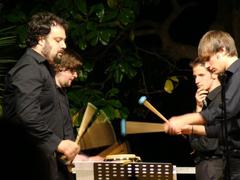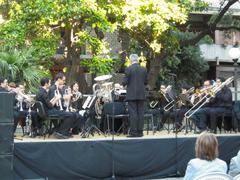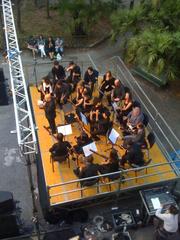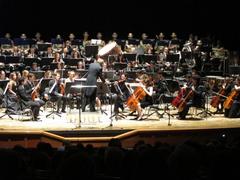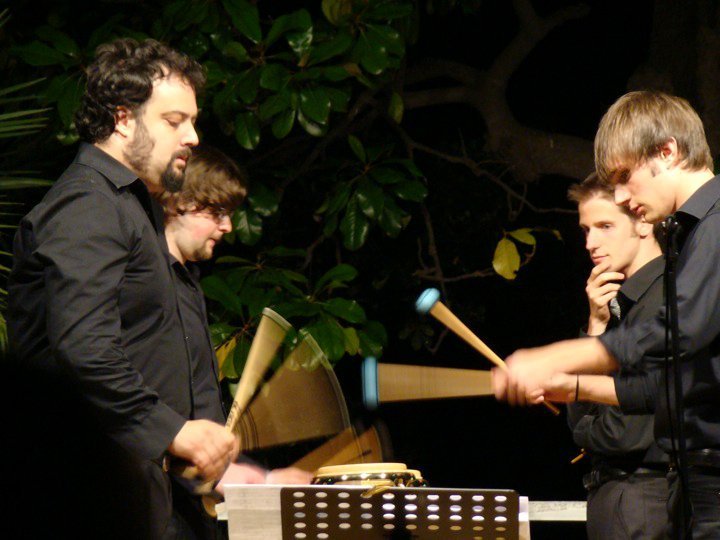
Visiting the Conservatorio Niccolò Paganini, Genoa: Tickets, Hours, and Visitor Guide
Date: 14/06/2025
Introduction
The Conservatorio Niccolò Paganini is a cornerstone of Genoa’s musical and cultural life. Located in the elegant Albaro district and the historic Palazzo Senarega, this institution is not only a place of world-class music education but also a living testament to the city’s rich artistic heritage. Whether you are a music lover, a culture enthusiast, or a traveler exploring Genoa’s historical sites, this comprehensive guide will help you plan your visit, covering practical information on visiting hours, ticketing, architectural highlights, and nearby attractions (conspaganini.it; it.wikipedia.org; studyabroadaide.com).
Historical Background
Founded in 1829 as the “Scuola gratuita di canto,” the institution was established to train choristers for Genoa’s Teatro Carlo Felice. Over nearly two centuries, it has evolved through various phases:
- Founding Years (1829–1866): Established by Antonio Costa and Filippo Granara, initially housed in modest quarters and later moving to the Monastero delle Grazie.
- Expansion and Civic Rebirth (1866–1930): Reopened by the city after a brief closure, renamed as Civico Istituto Musicale, and expanded its curriculum.
- Modernization and State Recognition (1930–1974): Achieved equivalence with state conservatories, relocated to Villa Raggio and then to its current premises.
- Contemporary Era (1974–Present): Officially became a state conservatory, now based in Villa Sauli Bombrini Doria, and remains an active hub for international and Mediterranean musical exchanges.
The conservatory is named after Niccolò Paganini, the legendary Genoese violinist, and continues to honor his legacy through education, concerts, and cultural initiatives (conspaganini.it; it.wikipedia.org).
Location and Accessibility
Campuses
- Villa Sauli Bombrini (Via Albaro, 38): The main campus, set within historic gardens in Albaro.
- Palazzo Senarega (Piazza Senarega, 1): A Renaissance palace in Genoa’s UNESCO-listed old town.
Both are accessible by public transport. The Genova Brignole railway station is nearby, and several AMT bus lines serve the area. Parking is limited; using public transport or taxis is recommended.
Accessibility
- Mobility: Both sites offer ramps and elevators, but due to their historic nature, some areas may be less accessible. Contact the conservatory in advance for specific needs.
- Language: Italian is the primary language, but English support is generally available, especially during international events.
Visiting Hours and Tickets
The conservatory is primarily an educational institution, and regular tourist visiting hours are not maintained. Public access is available mainly during:
- Concerts & Performances: From September to June, with schedules posted on the official website.
- Open Days & Festivals: Such as Open Week in May and European Heritage Days.
- Special Events: Including masterclasses, exhibitions, and academic conferences.
Administrative Office Hours:
- Monday: 12:00–13:00 (faculty only)
- Tuesday–Thursday: 11:00–12:00 and 14:00–15:15
- Friday: 11:00–12:00
- Telephone Reception: Tuesday–Saturday, 12:00–13:00
Ticketing:
- Concert tickets usually range from €5–€20.
- Many student recitals and open rehearsals are free.
- Tickets can be booked via the official events page or at the venue, subject to availability.
- Early booking is advised for major events.
Guided Tours and Special Access
- Regular Tours: Not offered daily, but available during Open Week, European Heritage Days, or by prior arrangement for groups.
- Group Visits: Educational and group tours can be arranged via the contact page.
- Exhibitions: The library and archives occasionally host exhibitions featuring rare manuscripts and memorabilia.
Architectural and Cultural Highlights
- Villa Sauli Bombrini: Features 19th-century architecture, lush gardens, and modernized classrooms.
- Palazzo Senarega: Renaissance interiors, period furnishings, and performance spaces.
- Concert Hall: Renowned for acoustics, hosting faculty, student, and guest performances.
- Library: Houses over 50,000 volumes, including rare Paganini manuscripts; access is mainly for students and researchers, but public exhibitions occur during special events.
Concert Experience
Performances feature a range of genres, from classical and jazz to contemporary works. The intimate concert hall seats around 300 and offers excellent acoustics. For concertgoers:
- Arrive at least 20 minutes early.
- Smart-casual attire is standard; formal wear for gala events.
- Photography and recording are not allowed during events.
Visitor Conduct and Facilities
- Etiquette: Maintain silence in academic areas; follow staff instructions.
- Amenities: Restrooms available during events; no public cafeteria, but many cafés and restaurants are nearby.
- Safety: Security staff are present during events; emergency procedures are in place.
Practical Tips
- Advance Planning: Always check the events calendar and book tickets early.
- Combine Visits: The conservatory is near Genoa’s major historical attractions—consider planning a day around your visit.
- Language Support: Bilingual programs for major events and English-speaking staff are usually available.
Nearby Attractions
- Piazza De Ferrari: Genoa’s main square, close to Palazzo Senarega.
- Genoa Cathedral: A short walk from the old town campus.
- Via Garibaldi and Palazzi dei Rolli: UNESCO-listed Renaissance palaces.
- Museo d’Arte Contemporanea di Villa Croce: Near Albaro.
- Corso Italia: Genoa’s scenic seafront promenade.
FAQs
Q: What are the Conservatorio Niccolò Paganini visiting hours?
A: There are no daily tourist hours; public access is during events and special open days. Check the official website for details.
Q: How do I buy tickets?
A: Reserve online via the events page or at the venue.
Q: Is the conservatory wheelchair accessible?
A: Most areas are accessible, but contact the staff for specifics due to the historic architecture.
Q: Are guided tours available?
A: Yes, during special open days or by prior arrangement.
Q: Can I take photographs?
A: Not during performances or classes; permission may be granted during open days.
Q: What else can I visit nearby?
A: Piazza De Ferrari, Genoa Cathedral, Palazzi dei Rolli, and the city’s waterfront.
Further Information and Online Resources
- Conservatorio Niccolò Paganini Official Website
- Mentelocale Open Week 2025
- Visit Genoa - Musica Donata Series
- Study Abroad Aide: Genoa Conservatory
- Wikipedia: Conservatorio Niccolò Paganini
Conclusion and Recommendations
The Conservatorio Niccolò Paganini is not only a landmark for music education but also a cultural hub that bridges Genoa’s past and present. By attending a concert, joining a special tour, or simply exploring its historic surroundings, visitors can immerse themselves in the vibrant spirit of Italian music and heritage.
For the latest concert schedules, ticket booking, and exclusive content, download the Audiala app and subscribe to the conservatory’s official channels. Plan your visit to experience one of Italy’s most storied music institutions and the city that inspired Paganini himself.
Sources
- https://www.conspaganini.it/content/storia
- https://it.wikipedia.org/wiki/Conservatorio_Niccol%C3%B2_Paganini
- https://studyabroadaide.com/institutions/genoa-conservatory/
- https://www.mentelocale.it/genova/79280-open-week-2025-del-conservatorio-niccol-paganini-porte-aperte-ed-eventi.htm
- https://www.visitgenoa.it/en/node/25014
